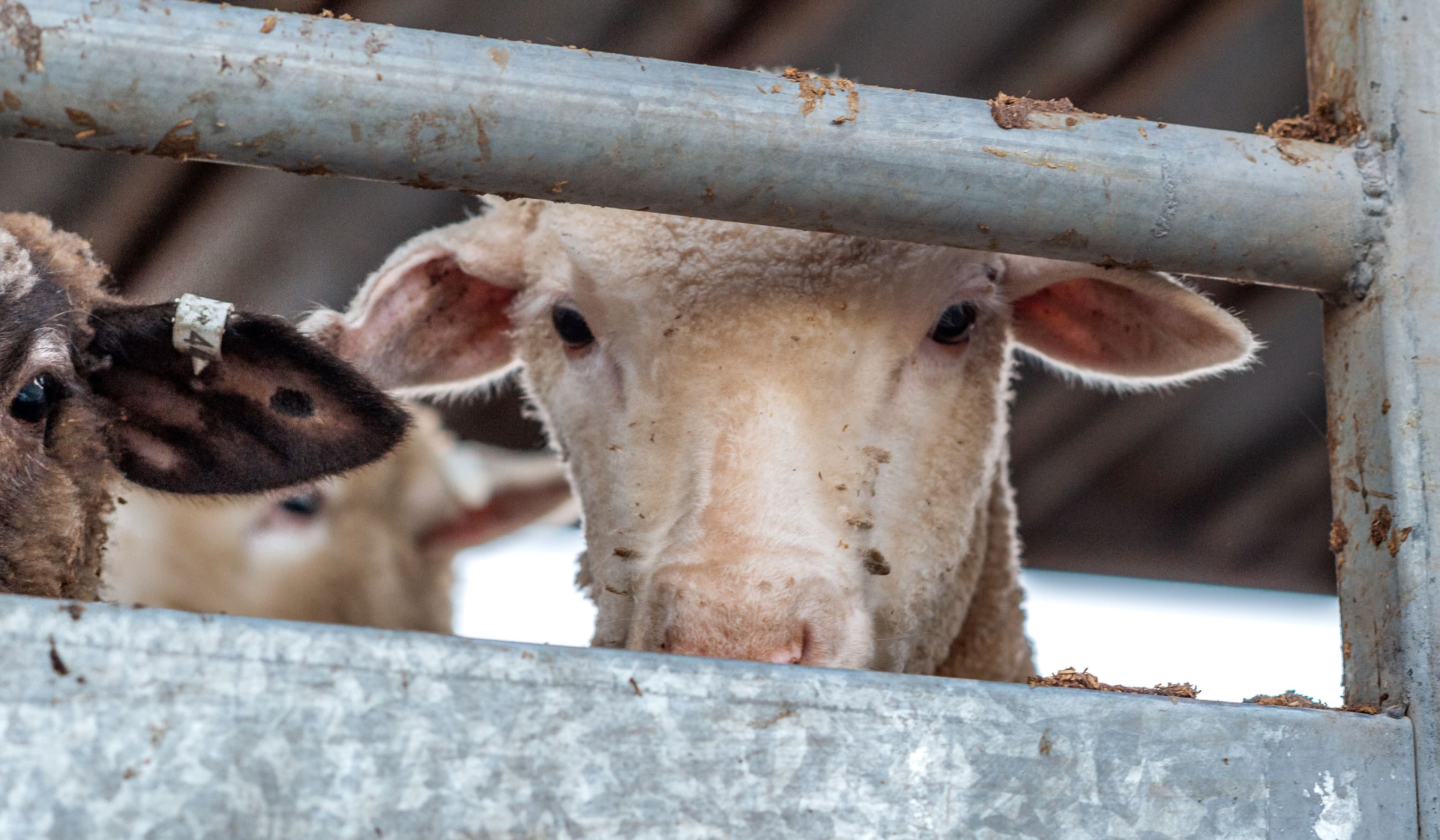




The removal of their tails is one of many abuses that young sheep endure. No matter the method, tail-docking has been shown to cause pain in lambs.

Removing (or "docking") lambs' tails is a painful procedure that's performed on very young animals, usually without anesthetic. Tail-docking's benefits are questionable, but its cruelty is undeniable.
WHAT IS TAIL-DOCKING?
Tail-docking involves the removal of portions of the tails of various species of farm animals. The tails of mammals are filled with nerves, blood vessels, and vertebrae since the tail is essentially an extension of the spine. Docking involves the severing of several of these bones, and yet it's virtually always performed without any anesthesia, making it acutely painful during the removal process and for several days afterward.
DO LAMBS HAVE TAILS?
Yes. Many different breeds of sheep exist throughout the world, each with varying lengths of tails. Some breeds are born with stumpier tails that are not targeted for docking, while lambs of other breeds are born with long tails that can grow several feet in length if left intact. Some breeds of sheep found in parts of Africa, the Middle East, and other regions even store fat in their tails, which can grow so large that they drag on the ground.
WHY DO THEY CUT OFF LAMBS' TAILS?
The tails of lambs are cut off to prevent blowfly strike, a type of parasitic infection. These infections can lead to fertility problems, decreased wool production, and sometimes death. Blowfly strike is thought to be associated with the buildup of fecal material on the sheep’s tail, but there is no scientific consensus on the issue.
HOW ARE LAMBS' TAILS DOCKED?
Tail-docking in lambs usually occurs at a young age, normally within weeks of being born. There is still debate about which docking method causes the least pain, yet each one of these methods has been shown to result in pain posturing, crying or screaming, and increased stress.
Rubber ring
The rubber ring docking method involves placing a tight latex band around the tail to cut off blood flow to the tail. The band applies constant pressure, eventually resulting in an inflammatory lesion and the sloughing off of the tail, meaning the tail rots without sufficient blood supply and eventually detaches from the body on its own.
This process generally takes nearly a month to complete, during which lambs exhibit various pain and stress responses.
Rubber ring followed by crushing
This method involves applying a latex or rubber band to the tail as described above, with the additional step of applying a clamp forcefully to the tail near the ring to destroy the underlying nerves in the tail.
Hot blade
Some farmers use a surgical knife to sever the tail, followed by cauterization with a hot blade. Cauterization is like receiving a burning hot brand to the skin, except when applied to an open wound, the searing heat seals off blood vessels. While excruciatingly painful, cauterization is thought to aid with the healing process.
WELFARE CONCERNS
Welfare concerns arise anytime an animal is made to suffer significant or unnecessary harm at the hands of humans. Tail-docking presents many such concerns. It's not hard to imagine why cutting off part of a lamb’s body might cause extreme pain. All bodies—including those of human beings—have evolved to serve important biological functions. The body’s nervous system is perpetually on high alert for any damage or threat to any part, no matter how big or small. Severing or damaging any body part will inevitably be accompanied by some degree of pain, no matter the species or age of the victim.
The American Veterinary Association concedes that tail-docking causes “significant discomfort”, and studies have shown heightened cortisol responses, which indicate stress. On many farms, tail-docking is performed with little consideration to the pain that lambs may experience, so pain medication is rarely administered, especially with the rubber ring method.
DO OTHER ANIMALS HAVE THEIR TAILS DOCKED?
Several other farm animals are forced to endure tail-docking. The reasoning for tail-docking is usually related to the highly unnatural conditions on factory farms.
On dairy farms, cows' tails are docked allegedly to help with hygiene, something that's nearly always compromised on factory farms because animals are held at high stocking densities in very small areas, leading to the rapid build-up of excrement. Yet tail-docking cows is mired in controversy, as there is little scientific evidence to show that it's anything more than a convenience for farmers while causing unnecessary suffering to the cows. It seems that the real reason farmers cut off the tails of cows is because it makes milking easier.
Pigs on factory farms are also normally tail-docked. In the wild, pigs live in complex social groups and don't usually display chronic aggression toward each other. But the endless stress caused by the barren and crowded conditions on factory farms gives rise to unnatural levels of hostility and boredom. The end of a pig's tail is covered with a tuft of hair, something that is thought to act as a target for other pigs to bite, so this portion of the tail is commonly removed, if not more. The docking is also meant to cause pain to pigs so that they will more actively avoid being bitten by their fellow captives.
WHAT YOU CAN DO TO HELP
Like other young animals on farms, lambs receive treatment that is appalling, especially considering how gentle, cheerful, and boisterous lambs' personalities can be. Tail-docking is one of many painful mutilations sheep endure in their first weeks of life, followed by years of total domination by people until their untimely slaughter.
To get involved in the movement to improve the lives of these animals and others, visit our Take Action page.





